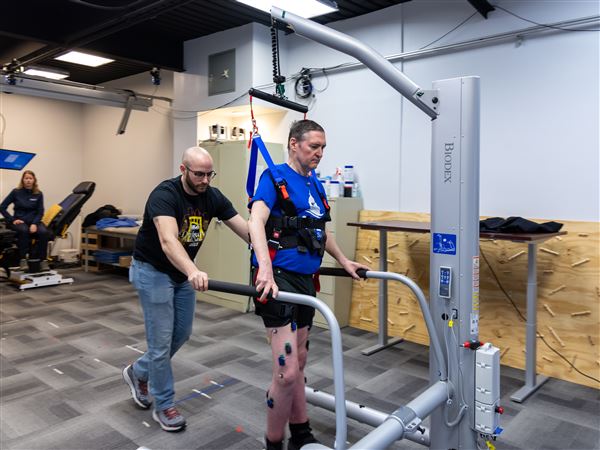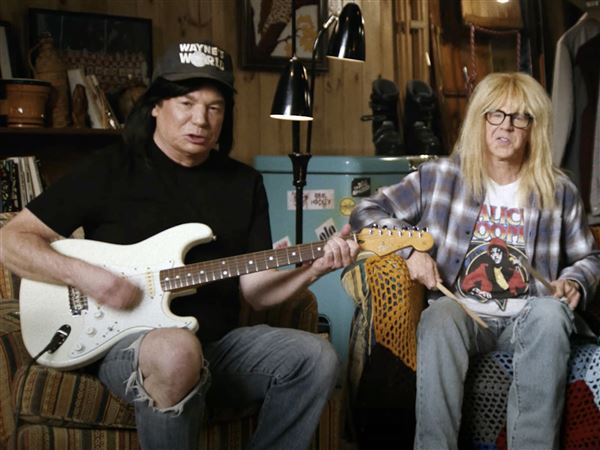Mellon Arena has hosted spectacles of all kinds, from monster-truck pulls to head-banging heavy-metal shows. But the arena has never seen the likes of its visitors this week: a herd of roaring life-size animatronic dinosaurs.
The show "Walking With Dinosaurs -- The Live Experience" is a stage version of the BBC Television series, and it is driven by a new breed of special effects, one based on physics and mechanics, along with a large dash of creativity. The dinos' two-year U.S. tour makes a stop here beginning Wednesday for a five-day run.
The $20 million spectacle by The Creature Production Co. is designed for large-scale venues and takes audiences through 200 million years, tracing evolution, climate and tectonic change. The cast of 15 dinosaurs includes 10 species ranging from the Triassic through the Jurassic and Cretaceous periods. As with any theatrical venture, it has its major stars: the biggest, the long-necked Brachiosaurus, measuring 36 feet tall and 56 feet long; and the baddest, Tyrannosaurus rex, which stands 23 feet tall and 42 feet long.
Where: Mellon Arena
When: Wednesday through Dec. 7. Wednesday-Friday 7 p.m.; Saturday 11 a.m., 3 and 7 p.m.; Sunday 11 a.m. and 3 p.m.
Tickets: Wednesday night $20.50-$78.75; other nights $30-$78.75. 412-323-1919 or www.dinosaurlive.com
The large dinosaurs are mounted on hydraulic-powered bases. Their movements are guided by a team of three -- a driver, who operates the wheeled chassis, and two puppeteers, who use remote controls to direct the dinosaur's movements. The five smaller dinosaurs -- which include a baby T rex, are built on a frame and worn by the actors like a backpack. There's one human character, a paleontologist, who serves as narrator and guide.
Audiences used to state-of-the-art movie effects should park those expectations at the door. "Meeting those expectations is always tough," says director Scott Faris. "With this, it was particularly tough because we were re-creating the television documentary in a live setting. So that really sets a high standard."
But for creature designer/builder Sonny Tilders, seeing his dinosaurs in a live, three-dimensional setting is even more fun than watching them on a screen. "When they get translated to the flat screen, it's often a disappointment" for an effects designer, he says. "It looked cooler back in the workshop. So it's really nice to be able to bring that level of animatronics to a live context."
Tilders has been making critters for stage and screen for the past 18 years, including stage productions of "The Hobbit" and "The Lion, the Witch and the Wardrobe." His film credits include "Star Wars: Episode I -- The Phantom Menace," "Peter Pan" and "Ghost Rider." He was lead animatronic engineer for the Jim Henson Creature Workshop's TV series "Farscape."
It took Tilders and his crew about a year to design and build the "Walking With Dinosaurs" cast. They're now working on a duplicate show that will tour Europe and Asia.
Building a convincing scientifically accurate dinosaur for the stage presented a raft of design challenges, Tilders says. "The live context presents so many other issues that you don't have to deal with on [a movie] set."
In film, for example, designers may build only the portion of the creature that will be seen on screen. And the stage dinos need to be much more durable. In film, the effect needs to hold up "as long as it takes that last take to be done. You hold it together so the head doesn't fall off, and you're done."
A stage full of ambling, roaring dinosaurs can make audiences forget the flashy computer graphics they're used to seeing on screen -- and the experience can get intense for young audience members. No matter how much a youngster loves the idea of dinosaurs, seeing these larger-than-life-size creatures in the skin (even if it's latex) is a very different experience. "For what we can't do in terms of the dynamics you can achieve by film, we certainly more than make up for it by that very visceral sense," Tilders says.
The dinosaur's skins and the hydraulics that drive their movements are the keys to why these dinosaurs represent an evolutionary leap in this type of animation. "One of the key things was developing a hydraulic system that moves as fluidly as it does," Tilders explained. "Hydraulics are generally used to drive things that need a lot of power. It doesn't necessarily make for something that moves softly and fluidly."
Because the larger dinosaurs are so massive, keeping their weight down was crucial, which meant the skins had to be made out of a light material. "We threw out all the things you would use on film sets" and opted for a modified lycra/spandex material, combined with inflatables.
"The payoff has been that they move so beautifully. They're able to compress and contract, where other structures don't.
"It really makes you reflect on the engineering of the actual creature," Tilders adds. "We're doing it with all these lightweight techniques -- inflatable bodies, no muscle mass, none of the big chunks of heavy stuff the dinosaurs had. How did they do it? How did they hold their heads up like that?"
For as big as the players are, it's often the small details that captivate audiences, such as the way the eyes move, blink and glint.
Like its TV predecessor, the stage version of "Walking With Dinosaurs" strives for scientific accuracy. The models are built to scale, based on fossil records, and their motion is carefully designed to reflect how something of that size and weight would have moved.
"We looked at elephants and other large animals, studied their moves and spent time refining them," Tilders says. "We were fortunate to have the BBC series go before us. We looked at the interpretations their CG guys have done."
Faris is a stage veteran whose latest project was as director of the Las Vegas production of Bette Midler's "The Showgirl Must Go On." Working with a cast of dinosaurs instead of human actors is something of a departure on his resume, but the experience wasn't all that different, he says. "We wanted the story to follow traditional drama -- rising action, conflict and resolution, so that we had two acts that survived on solid theatrical principles."
The drama of a mother T rex defending her baby is universal and draws audiences in. "When it's film or theater or spectacle, if the audience doesn't care about the characters you're presenting or the story, they tune out, no matter how many special effects you have. So you have to get back to that theatrical principle -- make the characters someone they care about."
One of the TV series' appeals was its epic battles to the death. While there's fighting on stage, no dinosaurs are torn apart and eaten because, as Faris puts it, "We have to do eight shows a week. These are million-dollar robots. We can't tear one apart. They do attack and strike each other, but nobody really gets devoured."
First Published: November 30, 2008, 10:00 a.m.

















